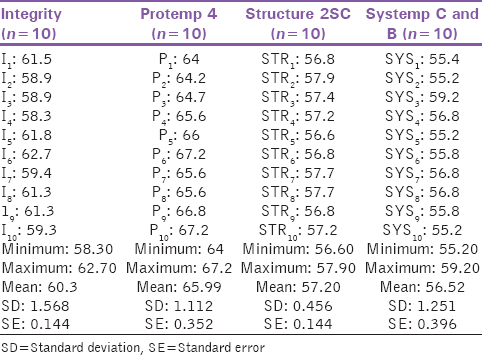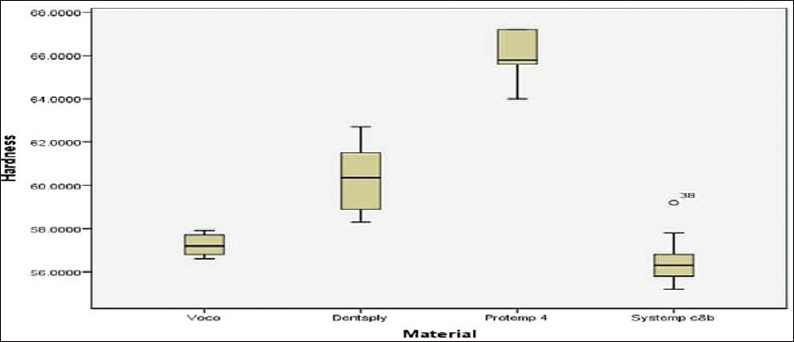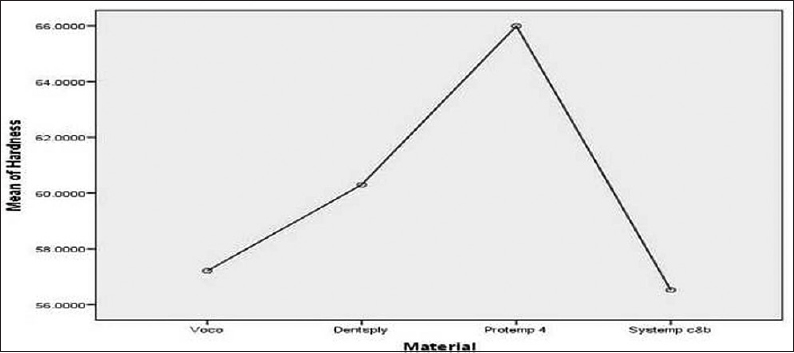|
 
 |
| ORIGINAL ARTICLE |
|
| Year : 2016 | Volume
: 4
| Issue : 3 | Page : 51-55 |
|
Comparative evaluation of hardness of four provisional restorative materials: An in vitro study
Muralidhar Reddy Pereddy1, S Janani2, Brajesh Gupta3, Venu Madhav Gajula1
1 Department of Prosthodontics, Mamata Dental College and Hospitals, Khammam, Telangana, India
2 Department of Prosthodontics, Rajarajeswari Dental College, Bengaluru, Karnataka, India
3 Department of Prosthodontics, Sri Sai College of Dental Surgery, Vikarabad, Telangana, India
| Date of Web Publication | 31-May-2017 |
Correspondence Address:
Muralidhar Reddy Pereddy
Department of Prosthodontics, Mamata Dental College and Hospitals, Khammam - 507 002, Telangana
India
 Source of Support: None, Conflict of Interest: None  | Check |
DOI: 10.4103/EJP.EJP_29_16

Purpose: The present in vitro study was conducted to evaluate and compare the hardness of four commercially available provisional restorative materials. Materials and Methods: The groups in the study were Protemp 4 group, Integrity group, Systemp C and B group, and Structure 2SC group ten specimens of dimensions 64 mm × 3.5 mm × 12.3 mm × 65 mm × 13.5 mm of each material was made. Moreover, a total of forty specimens were used in the study and were tested for micro hardness and the values obtained were evaluated. One-way analysis of variance was applied to the data, and post hoc test was carried out for intercomparison between groups. Results: The findings showed that mean hardness value of Protemp 4 which had the highest value of 65.990 Vickers hardness number (VHN) followed by integrity 60.300 VHN followed by 57.210 VHN in Structure 2SC and least of 56.520 VHN in System C and B group and it was found to be statistically significant. The post hoc test revealed there was evident between Voco (Structure 2SC) and Systemp C and B materials; there was no statistical difference in mean hardness of the material in comparison with Protemp 4 and Integrity. Conclusion: Protemp 4 showed the highest hardness followed by integrity, Structure 2SC and Systemp C and B.
Keywords: Integrity, Protemp 4, provisional restorative material, Structure 2SC, Systemp C and B., Vickers hardness test
How to cite this article:
Pereddy MR, Janani S, Gupta B, Gajula VM. Comparative evaluation of hardness of four provisional restorative materials: An in vitro study. Eur J Prosthodont 2016;4:51-5 |
How to cite this URL:
Pereddy MR, Janani S, Gupta B, Gajula VM. Comparative evaluation of hardness of four provisional restorative materials: An in vitro study. Eur J Prosthodont [serial online] 2016 [cited 2018 Jun 29];4:51-5. Available from: http://www.eurjprosthodont.org/text.asp?2016/4/3/51/207367 |
| Introduction | |  |
Provisional crowns and fixed partial dentures are vital components of fixed prosthodontic treatments. They should protect pulpal tissue from physical, chemical and thermal injuries, and must maintain occlusal function and stability, and esthetics.[1] The provisional restorative materials should fulfil mechanical, biologic, and esthetic requirements until the placement of definitive restorations.[2],[3] These materials should have certain mechanical properties, such as flexural strength, hardness, and wear resistance to with stand the complex environment of oral cavity.[4],[5],[6],[7] Provisional restorative materials are classified as methyl methacrylates, ethyl methacrylates, bis-acryl resin composites, and light-cured composites. Provisional restorations are also used as diagnostic tool for checking the altered occlusion and pulpal response.[8],[9],[10]
The materials used for fabrication of provisional restorations includes pigments, monomers, filler and an initiator, all combining to form an esthetic restorative substance. The important characteristics of the material are determined by the primary monomer. The ability of this monomer to convert to a polymer allows the material to set into a solid that is durable enough to withstand the oral environment and occlusal forces for an interim period.[11],[12]
A provisional restoration is a fixed or removable prosthesis designed to enhance esthetics, stabilization or function for a limited period of time after which it is to be replaced by a definitive dental prosthesis.
Clinicians must be familiar with the commercially available interim materials and their mechanical properties so that they can select the best material depending on the clinical situations.
Hence, with this background, the present in vitro study was conducted with an aim to evaluate and compare the hardness of four commercially available provisional restorative materials.
| Materials and Methods | |  |
Provisional restorative material selected [Figure 1]:
- Integrity: Bis acryl resin based provisional restorative material containing multifunctional methacrylates
- Protemp 4: Bis acryl resin based provisional restorative material containing bifunctional methacrylates
- Structure 2SC: Bis acryl resin based provisional restorative material containing methacrylates
- Systemp C and B: Bis acryl resin based provisional restorative material containing methacrylates.
Description of the mold
A master die was machined with dimensions (64 mm × 3.5 mm × 12.3 mm × 65 mm × 13.5 mm) according to ADA specification no 13 for determining hardness.[13] This master die was used to prepare a mold. Lower portion of the 3 piece brass flask was filled with freshly mixed type III dental stone with a standard powder/water ratio, 100 g powder to 30 ml water and the stainless steel dies were placed into this mixture. Cold mold seal was applied on the set stone surfaces and the upper portion of the selected flask was positioned on top of the lower portion of the flask and flasking was completed by pouring stone into the second half of the flask and secured with the lid and placed on a bench press and allowed to set. After setting, the flasks were opened following removal of the dies from the lower half of the flask.
Fabrication of the specimen
Provisional restorative material from the auto mixing gun was dispensed into the mold space and the other half was secured in place and placed on a bench press to permit even pressure throughout the mold space and allowed to cure as recommended by the manufacturer. After polymerization of the specimens, flasks were opened and flash from the specimens were removed with BP blade no 12 and the specimens were grossly trimmed, ground with the silicon carbide bur to remove any superficial layer of set material and polished to high gloss using 600 grit abrasive and diamond polishing paste. 10 specimens of each provisional restorative material were fabricated and a total of 40 specimens were tested in the study [Figure 2].
Testing of the specimen
Baseline Vickers hardness number (VHN) was measured after 24 h of fabrication with a micro hardness tester (model MVH, Omnitech, Pune, India), microhardness was determined by mounting it on the microindenter and loading each specimen for 15 s with a force of 100 g, after a square pyramid shaped indentation was obtained on each specimen, and its image was transferred to the computer monitor with the help of the microscope along with the micro hardness tester [Figure 3],[Figure 4],[Figure 5].
Formulae used
The lengths of the diagonals of the indentation were measured and VHN corresponding to each indentation for 40 samples was calculated using the formula:

Where, HV = Vickers hardness number; F = Load in kgf; d = Arithmetic mean of the two diagonals, d 1 and d 2 in mm.
Statistical analysis
One-way analysis of variance (ANOVA) and post hoc test were applied to test the significant difference.
| Results | |  |
[Table 1] shows the descriptive statistics of mean and standard deviation of hardness of different provisional restorative materials. [Table 2] shows the one-way ANOVA used to analyze total data where the value of P< 0.05 was found to be significant. [Table 3] shows the post hoc test results where it was evident that between Voco (Structure 2SC) and Systemp C and B materials there was no statistical difference in mean hardness of the material in comparison with Protemp 4 and Integrity [Figure 6] shows the box plot of hardness of provisional restorative material and is evident that in Protemp 4 the hardness is more when compared with other three materials and it is followed by Dentsply, Voco and Systemp C and B. [Figure 7] shows the mean plots between provisional restorative materials. | Table 1: Mean and standard deviation of hardness (Vickers hardness number) values between four different provisional restorative materials (n=10)
Click here to view |
 | Table 2: Statistical comparison (one.way analysis variance of hardness) (Vickers hardness number) values between different provisional restorative materials
Click here to view |
 | Table 3: Post hoc analysis of hardness (Vickers hardness number) values between different provisional restorative materials
Click here to view |
 | Figure 6: Box plot of mean and hardness (Vickers hardness number) values between four different provisional restorative materials
Click here to view |
 | Figure 7: Mean plots of hardness (Vickers hardness number) values between different provisional restorative materials
Click here to view |
| Discussion | |  |
Various materials have been available for provisional restorations. They can be prefabricated or custom made. Prefabricated restorations such as clear celluloid shells, polycarbonate crown forms, metal crowns are readily available while provisional can be custom made from material such as polymethyl methacrylate, polymethacrylate, polyvinyl methacrylate, bisacryl composite resin and visible light cured, urethane dimethacrylate.[14],[15]
Auto polymerizing resins have been used to fabricate provisional restoration by various methods with the introduction of composite based materials which may be chemically; light or dual cured acrylic resin which has lost their popularity.[16] Composites are used over acrylic because of chemical irritation and allergic reactions to acrylics caused by methyl methacrylate monomer over the amine accelerator, causing the composites to gain popularity over the acrylics.[17],[18]
Surface hardness is used as an indicator of density and it can be hypothesized that a denser material would be more resistant to wear and surface deterioration.[19] When a provisional restoration is fabricated with a material having a good wear resistance, the risk of perforation is greatly decreased, maintaining its structural integrity for a longer period. There are several types of hardness tests such as Barcol, Brinell, Rockwell, Shore, Knoops and Vickers. The selection of the test was dependent on the material being studied. In this study, VHN (micro hardness test) was determined which is based on the ability of the surface of any material to resist the penetration of a specific tip with a given load for a specific time.
The specimens for this study were prepared by using ADA specification no 13[13] for determining hardness. A customized steel die of dimensions (64 × 3.5 × 12.3 × 65 × 13.5) was machined and used to fabricate the auto polymerizing bis-acryl resin specimens with flasking procedure. Schulze et al.[20] investigated the micro hardness changes of five chemically and five light curing composites after accelerated aging from light exposure and they concluded that hardness increases with accelerated aging.
A study was carried out to compare the flexural strength of 5 methacrylate based resins and 8 Bis-acryl resins used to fabricate provisional crowns and fixed partial dentures. It was concluded that within the limitations of the study, flexural strengths were material than category specific. Some, but not all, bi-acryl resins demonstrated significantly superior flexural strength over traditional methacrylate resins.[13]
A study was done to investigate the flexural strength and flexural modulus of four (3 bis acrylate and 1 polymethyl methacrylate) provisional crown and bridge materials at different storage times after mixing using materials with different storage curing mechanism (dual curing vs. self-curing) the specimens were stored for 10 min, 2, 16, 24, 72 h. The materials were subjected to three point bend test at various times after mixing (37°C dry/water) including thermocycling (×5000, 5.55°C). The chemical nature and curing mechanism significantly influenced the mechanical properties; however, the influence of the curing mechanism disappeared at progressive points in time after mixing. Flexural time and flexural modulus significantly depend on the time after mixing. Composite based provisional crown and bridge materials should be preferred over methacrylate resins due to favorable mechanical properties.[21]
This study was conducted for evaluating the in vitro hardness between the commercially available bis acryl resin based provisional restorative materials Integrity, Structure 2SC, Systemp C and B, Protemp 4. The provisional restorative material represent different chemical contents i.e. Integrity from Dentsply group represent methacrylates with barium glass and fumed silica, Structure 2SC from Voco group represent methacrylates with terpenes, amines and benzoyl peroxide, butylated hydroxy toluene, Systemp C and B from Ivoclar Vivadent group represent polyfunctional methacrylates and inorganic fillers, plasticizers and stabilizers, Protemp 4 from 3 M ESPE group contains dimethacrylate polymer and bis gma resins with fillers and stabilizers represents however the contents and except a few descriptive words regarding strength have not been disclosed by the manufacturer.
| Conclusion | |  |
From the results of the present study, we conclude that Protemp 4 (3 M ESPE) showed the highest hardness followed by Integrity (Dentsply), Structure 2SC (Voco) And Systemp C and B (Ivoclar Vivadent) in descending order.
Financial support and sponsorship
Nil.
Conflicts of interest
There are no conflicts of interest.
| References | |  |
| 1. | Akova T, Ozkomur A, Uysal H. Effect of food-simulating liquids on the mechanical properties of provisional restorative materials. Dent Mater 2006;22:1130-4.  [ PUBMED] |
| 2. | Patras M, Naka O, Doukoudakis S, Pissiotis A. Management of provisional restorations' deficiencies: A literature review. J Esthet Restor Dent 2012;24:26-38.  |
| 3. | Perry RD, Magnuson B. Provisional materials: Key components of interim fixed restorations. Compend Contin Educ Dent 2012;33:59-60, 62.  |
| 4. | Ireland MF, Dixon DL, Breeding LC, Ramp MH. In vitro mechanical property comparison of four resins used for fabrication of provisional fixed restorations. J Prosthet Dent 1998;80:158-62.  |
| 5. | Wang RL, Moore BK, Goodacre CJ, Swartz ML, Andres CJ. A comparison of resins for fabricating provisional fixed restorations. Int J Prosthodont 1989;2:173-84.  |
| 6. | Nejatidanesh F, Momeni G, Savabi O. Flexural strength of interim resin materials for fixed prosthodontics. J Prosthodont 2009;18:507-11.  |
| 7. | Luthardt RG, Stössel M, Hinz M, Vollandt R. Clinical performance and periodontal outcome of temporary crowns and fixed partial dentures: A randomized clinical trial. J Prosthet Dent 2000;83:32-9.  |
| 8. | Hernandez EP, Oshida Y, Platt JA, Andres CJ, Barco MT, Brown DT. Mechanical properties of four methylmethacrylate-based resins for provisional fixed restorations. Biomed Mater Eng 2004;14:107-22.  |
| 9. | Nejatidanesh F, Lotfi HR, Savabi O. Marginal accuracy of interim restorations fabricated from four interim autopolymerizing resins. J Prosthet Dent 2006;95:364-7.  |
| 10. | Lappalainen R, Yli-Urpo A, Seppä L. Wear of dental restorative and prosthetic materials in vitro. Dent Mater 1989;5:35-7.  |
| 11. | Rosentiel SF, Land MF, Fujimoto J. Contemporary Fixed Prosthodontics. New Delhi, India: Elsevier Inc.; 2007. p. 466-504.  |
| 12. | Shillingburg HT, Hobo S, Whitsett LD, Jacobi R, Brackett SE. Fundamentals of Fixed Prosthodontics. Caral Stream, United States: Quintessence Publishing Co. Inc.; 1997. p. 225-56.  |
| 13. | Donovan TE, Hurst RG, Campagni WV. Physical properties of acrylic resin polymerized by four different techniques. J Prosthet Dent 1985;54:522-4.  |
| 14. | Haselton DR, Diaz-Arnold AM, Vargas MA. Flexural strength of provisional crown and fixed partial denture resins. J Prosthet Dent 2002;87:225-8.  |
| 15. | Baldissara P, Comin G, Martone F, Scotti R. Comparative study of the marginal microleakage of six cements in fixed provisional crowns. J Prosthet Dent 1998;80:417-22.  |
| 16. | Young HM, Smith CT, Morton D. Comparative in vitro evaluation of two provisional restorative materials. J Prosthet Dent 2001;85:129-32.  |
| 17. | Craig's Restorative Dental Materials. 12 th ed. Philadelphia. United States: C V Mosby; 2006. p. 161-98.  |
| 18. | Yannikakis SA, Zissis AJ, Polyzois GL, Caroni C. Color stability of provisional resin restorative materials. J Prosthet Dent 1998;80:533-9.  |
| 19. | Diaz-Arnold AM, Dunne JT, Jones AH. Microhardness of provisional fixed prosthodontic materials. J Prosthet Dent 1999;82:525-8.  |
| 20. | Schulze KA, Marshall SJ, Gansky SA, Marshall GW. Color stability and hardness in dental composites after accelerated aging. Dent Mater 2003;19:612-9.  |
| 21. | Balkenhol M, Ferger P, Mautner MC, Wöstmann B. Provisional crown and fixed partial denture materials: Mechanical properties and degree of conversion. Dent Mater 2007;23:1574-83.  |
[Figure 1], [Figure 2], [Figure 3], [Figure 4], [Figure 5], [Figure 6], [Figure 7]
[Table 1], [Table 2], [Table 3]
|